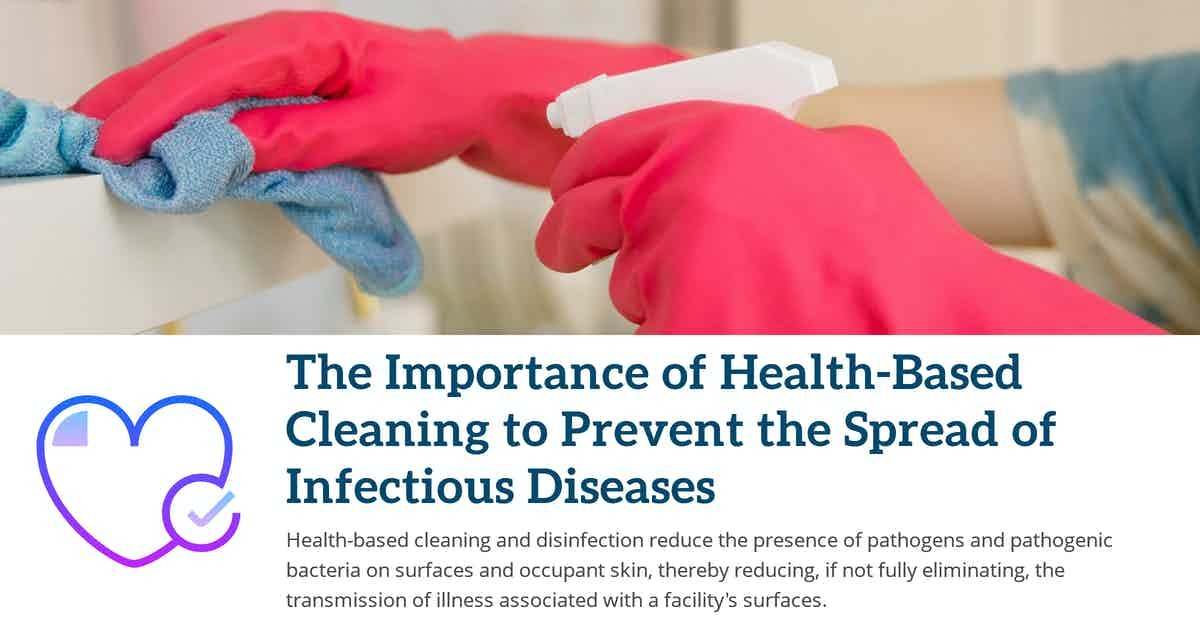Health-based cleaning and disinfection reduce the presence of pathogens and pathogenic bacteria on surfaces and occupant skin, thereby reducing, if not fully eliminating, the transmission of illness associated with a facility's surfaces.

Health-Based Cleaning Reduces the Spread of Disease
The transmission of human infectious disease is broken up into four categories:
- Airborne via inhalation.
- Common vehicle via food or water.
- Vector-borne via insects, and;
- Dermal via direct contact with a contaminated person or surface--conventionally referred to as a fomite.
Two common respiratory illnesses--influenza and pneumonia--are listed among the top 10 causes of death in the US each year, claiming nearly 50 thousand lives annually.
Respiratory illnesses, including SARS-CoV-2, have been observed spreading via multiple pathways, including airborne via aerosolized particles and droplets, and through dermal contact--typically by shaking hands with a contaminated person or by touching a contaminated surface, and then touching their eyes, nose, or mouth.
Health-based cleaning and disinfection initiatives paring both cleaning and targeted disinfection services with high levels of occupant hand hygiene compliance significantly reduce the presence and transmission of illness-causing germs and bacteria on facilities surfaces and occupant skin.
Surface Contamination
People spend most of their time indoors, more so lately, and where there are people, there are germs in the air and on facility surfaces.
The most common types of germs found on facility surfaces are respiratory, including:
- Influenza variants.
- Coronaviruses.
- Measles, and;
- Rhinoviruses.
However, enteric viruses (gut-related) are also prolific inside public facilities and commonly include:
- Norovirus.
- Astrovirus.
- Rotavirus, and;
- Hepatitis A.
These viruses have been shown to survive in an infectious state for several hours, sometimes for days, on the hard, non-porous surfaces found in public facilities.
Studies have shown that humans contacting these viruses with their hands can spread them from their point of origin to seven other surfaces--essentially contaminating an entire facility in a few hours.
Additional studies have demonstrated that certain facilities that see a high number of occupants are significantly more contaminated than others and include:
- Malls.
- Banks.
- Gyms.
- Theaters.
- Playgrounds.
- Restaurants.
- Offices.
- Daycares, and;
- Parks.
Regardless of the facility type, the more often a surface is touched, the more contaminated it likely is.
The most commonly touched and contaminated surfaces we come into contact with each day include:
- Phones.
- Tables.
- Handles.
- Doorknobs.
- Stairs.
- Escalators.
- Elevator & vending machine buttons.
- Restrooms, and;
- Countertops.
Cleaning & Disinfection
Maintaining a high level of facility hygiene and occupant health and safety requires an ongoing health-based cleaning and disinfection routine based on:
- Facility type/use.
- Occupant demographics.
- Foot traffic.
- Community outbreaks, and;
- Localized contamination.
In general, a public facility should be:
- Cleaned every day it is used with an EPA registered commercial-grade detergent.
- Subject to regular fomite disinfection multiple times per day with an EPA registered disinfectant.
- Routinely proactively decontaminated with an electrostatic disinfection appliance using an EPA registered disinfectant product, and;
- Regularly inspected to ensure cleaning and disinfection method efficacy and to identify any potential oversights or the need for protocol improvements.
In the event of a community-wide outbreak, the US Centers for Disease Control and Prevention recommend an increase in cleaning and disinfection frequencies.
In the event of a wider spread pandemic or localized contamination, the CDC recommends:
- Quarantining any potentially contaminated areas.
- Allowing the space to ventilate for 48 hours, if possible, before anyone re-enters the area.
- Deep cleaning and then disinfecting the contaminated area and then allowing it to ventilate completely before occupant re-entry, and;
- Increasing cleaning and fomite disinfection frequencies to multiple times per day for all occupied areas of the facility.
Hand Hygiene
Hand hygiene is critical for maintaining high levels of occupant health and surface hygiene between cleanings.
Unfortunately, hand hygiene compliance is next to impossible to regulate and enforce.
However, there are several steps any organization can employ to increase the likelihood of consistent, high-quality hand hygiene compliance, including:
- Providing and maintaining clean restrooms and handwashing stations.
- Providing free, easily accessible hand sanitizer.
- Providing free tissue.
- Providing free disinfectant wipes for workstations, common areas, and personal devices, and;
- Placing signage in strategic locations, such as break rooms, kitchens, and restrooms, reminding employees to wash their hands before returning to the workplace.
References & Resources
- Contact Transmission of Infectious Disease Agents: The Science and Implications for Cleaning and Disinfection of Surfaces
- Leading Causes of Death
- Good Hygiene Practices - Reducing the Spread of Infections and Viruses
Takeaway
Heath-based cleaning and disinfection paired with high levels of occupant handwashing compliance are proven methods for reducing the transmission of viruses and pathogenic bacteria from person-to-person or surface-to-person in public facilities.
Outsourcing is a proven method for onboarding increasingly in-demand sustainable cleaning for health services, tools, and expertise for a fraction of the cost of maintaining a similar service in-house.
If you would like more information regarding the effectiveness of high-performance infection prevention and control measures, or if you would like to schedule a free, no-obligation onsite assessment of your facility's custodial needs, contact us today for a free quote!
In Bakersfield, CA, call (661) 437-3253
In Fresno, CA, call (559) 206-1059
In Valencia CA, or Santa Clarita CA, call (661) 437-3253
In Palmdale, CA or Lancaster, CA, call (661) 371-4756

